Patio Deck Trends: Comfortable & Stylish Outdoor Spaces
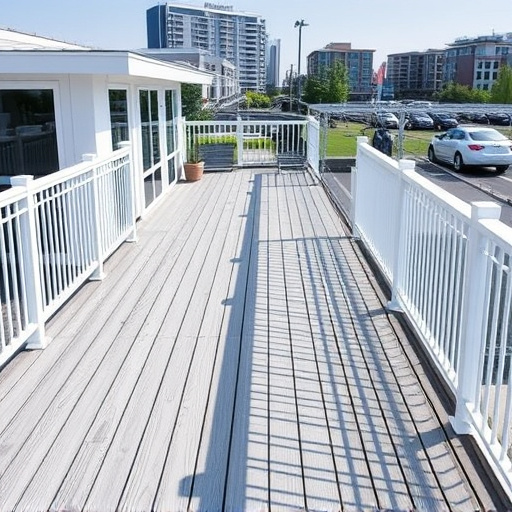
Cozy patio deck transformations create inviting outdoor spaces with comfortable seating, soft textur…….
Welcome to an exhaustive exploration of the patio deck, a versatile and increasingly popular outdoor living space that has captured the imagination of homeowners and designers worldwide. This article aims to guide readers through every facet of patio decks, from their foundational design principles to the latest innovations and global trends. By the end, you’ll grasp the profound impact and potential of this exterior oasis.
Definition: A patio deck is an extended outdoor living area attached directly to a house or built as a standalone structure. It bridges the gap between interior comfort and outdoor beauty, offering a versatile space for dining, entertaining, relaxation, or simply enjoying nature.
Core Components:
Decking Material: Wood (e.g., cedar, treated pine), composite materials (a mix of wood fibers and plastic), or concrete are common choices. Each material has unique characteristics regarding durability, maintenance, and aesthetics.
Frame Structure: Typically constructed using treated lumber or steel, the frame supports the deck and can incorporate various designs like box frames, platform decks, or multi-level configurations.
Decking Patterns & Layouts: From traditional rectangular shapes to intricate patterns like hexagonal or L-shaped designs, decking layouts cater to personal preference and space constraints.
Railings & Guardrails: Essential for safety, railings provide a barrier while allowing unobstructed views. Code requirements dictate height and material specifications for guardrails.
Historical Context: The concept of patio decks can be traced back to ancient civilizations like the Romans, who built open-air terraces. However, modern deck designs emerged in the mid-20th century with advancements in building materials and construction techniques. Today, they are a cornerstone of outdoor home improvement.
Patio decks have transcended geographical boundaries, leaving an indelible mark on the global landscape:
| Region | Trends & Influence | Notable Features |
|---|---|---|
| North America | Popular for backyard retreats, North American decks showcase a mix of traditional and modern styles. Composite decking is on the rise due to low maintenance requirements. | Multi-level decks with built-in seating areas and kitchens are common. |
| Europe | Emphasizes natural materials like wood and stone, blending seamlessly with European architecture. | Rooftop terraces and elevated decks are gaining popularity in urban centers. |
| Asia Pacific | Driven by a growing middle class, Asia Pacific markets see a surge in deck installations across residential and commercial properties. | Minimalist designs with seamless indoor-outdoor flow are favored. |
| Latin America | Integrates vibrant local aesthetics, incorporating colorful materials and intricate patterns. | Outdoor living spaces often double as social hubs within communities. |
These regional variations reflect diverse cultural preferences and climatic conditions, showcasing the adaptability of patio decks worldwide.
The patio deck market is a dynamic segment within the broader construction and outdoor living industries:
Market Dynamics:
Investment Patterns:
Economic Impact:
Technology plays a pivotal role in shaping the future of patio decks:
Composite Decking: Innovations in composite materials offer superior durability, low maintenance, and enhanced aesthetics compared to traditional wood decking.
Smart Decks: Integrating smart home technology allows for automated lighting, music systems, and temperature control, transforming decks into high-tech outdoor living spaces.
Modular Deck Systems: Pre-fabricated modular deck components streamline construction, reduce installation time, and offer a wide range of design possibilities.
Digital Design Tools: Online deck design platforms empower homeowners to visualize and customize their dream decks before construction begins.
Regulatory frameworks play a crucial role in ensuring the safety and quality of patio decks:
Building Codes: Local building codes dictate minimum requirements for deck construction, including load bearing capacities, railing heights, and material specifications.
Permits & Inspections: Many jurisdictions require permits for deck installations, followed by inspections to ensure compliance with code regulations.
Material Regulations: Certain materials, like treated lumber, may be subject to environmental regulations due to potential chemical treatments.
Accessibility Standards: Decks must adhere to accessibility guidelines, ensuring ease of use for individuals with disabilities.
Despite their popularity, patio decks face several challenges and criticisms:
Challenges:
Maintenance: Wood decking requires regular cleaning, sealing, and staining to prevent rot, mold, and insect infestation. Composite decking offers lower maintenance options but still needs occasional care.
Weather Exposure: Extreme weather conditions, such as heavy rainfall or scorching heat, can impact deck stability and aesthetics over time.
Cost: High-end deck materials and custom designs can significantly drive up installation costs.
Criticisms:
Environmental Impact: The production and disposal of certain decking materials raise environmental concerns.
Aesthetics: While decks offer outdoor living, some critics argue they can disrupt natural landscapes or appear too artificial in certain settings.
Case Study 1: Urban Rooftop Oasis
In a dense urban center, a creative team transformed a concrete rooftop into a vibrant patio deck. Utilizing modular systems and sustainable materials, the design incorporated green elements like vertical gardens and built-in seating areas. This project exemplifies how patio decks can adapt to limited spaces while enhancing urban living experiences.
Case Study 2: Rustic Lakefront Retreat
A rustic cabin on a serene lake benefited from a natural-looking deck constructed with treated pine and stone accents. The design seamlessly blended with the surrounding landscape, providing a private retreat for outdoor enthusiasts. This case highlights the versatility of patio decks in diverse natural settings.
Case Study 3: Modern Beachside Escape
A minimalist beach house featured a stunning patio deck designed with composite materials and glass panels to create an open-air living area while offering unobstructed ocean views. This application showcases the potential for modern aesthetics and seamless indoor-outdoor integration.
The future of patio decks is filled with exciting possibilities:
Sustainable Materials: Expect a growing emphasis on eco-friendly materials, such as recycled plastic composite decking and bamboo.
Smart Technology Integration: Advanced smart home technology will further enhance deck experiences, offering automated lighting, music, and even integrated cooking facilities.
Modular Design & Construction: Pre-fabricated modules will continue to revolutionize construction, enabling faster installations and greater design flexibility.
Personalized Experiences: Customization will be key, with homeowners creating tailored decks that reflect their unique personalities and lifestyles.
Patio decks have evolved from simple outdoor structures to multifaceted spaces that enhance modern living. They offer a sanctuary from the hustle and bustle of daily life, fostering connections with nature and loved ones. With technological advancements, sustainable materials, and innovative design trends shaping the industry, the future of patio decks appears brighter than ever. As these exterior retreats continue to evolve, they will undoubtedly remain a central element in our pursuit of elevated outdoor living.
1. How much does it cost to build a patio deck?
Costs vary widely depending on size, materials, location, and complexity. Basic wooden decks typically range from $25-$70 per square foot, while composite or luxury options can exceed $100 per square foot.
2. What is the best material for a patio deck?
The “best” material depends on personal preference, budget, and climate. Composite decking offers low maintenance, wood provides natural aesthetics, and concrete is durable and cost-effective.
3. Can I build a deck myself?
Complex decks are best left to professionals due to building code requirements and structural considerations. However, smaller, simpler decks can be DIY projects with proper planning and skill.
4. How do I choose the right size for my deck?
Deck size depends on available space and intended use. Consider seating capacity, flow between indoor and outdoor areas, and desired activities (e.g., dining, entertaining, relaxation).
5. Are decks prone to damage from weather?
Properly maintained decks can withstand various weather conditions. Wood treatments, sealing, and composite materials offer better resistance to rot, mold, and fading. Regular inspection and care are crucial.

Cozy patio deck transformations create inviting outdoor spaces with comfortable seating, soft textur…….
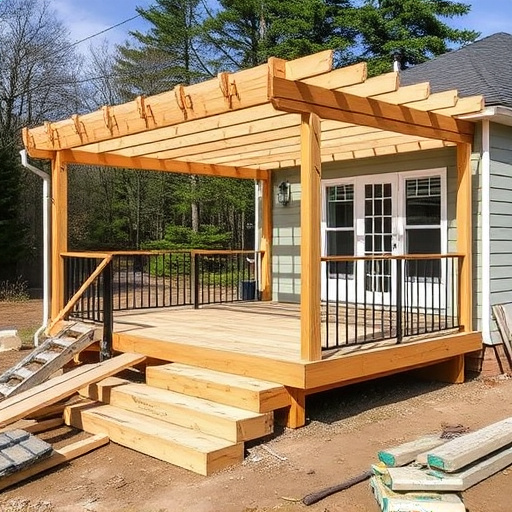
Transform your patio deck into a social hub with strategic seating, low tables, and outdoor rugs for…….
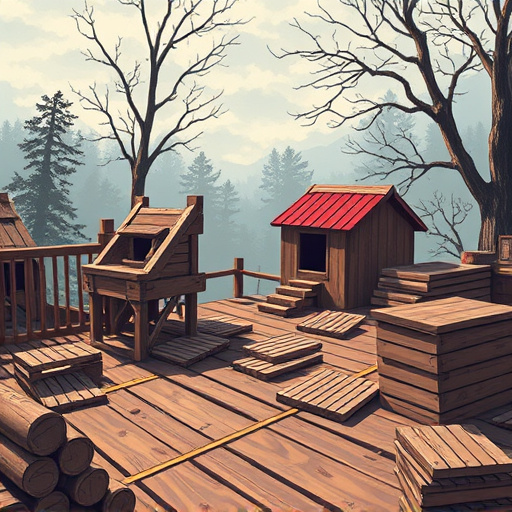
Transform your patio deck into a vibrant and functional outdoor space with creative ideas like new f…….

Assess skills and time before starting a patio deck project. Consider professional installation for…….
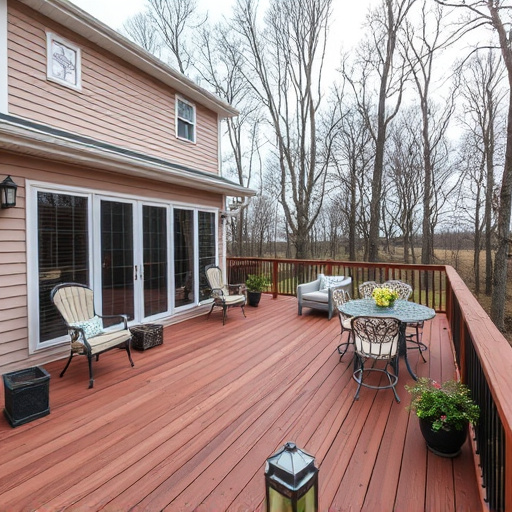
Transform your patio deck with budget-friendly materials like composite decking, vibrant colors, and…….
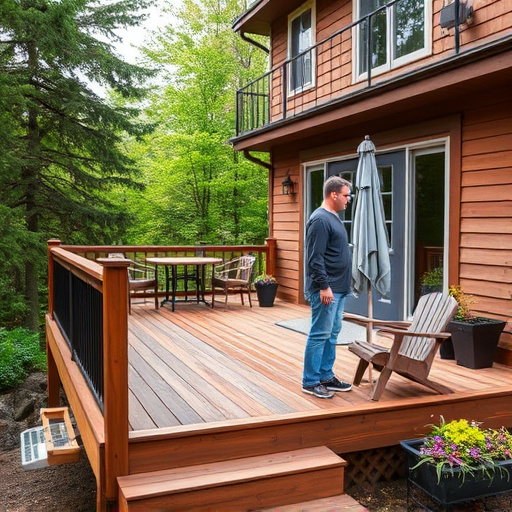
Choosing low-maintenance materials like composite decking, incorporating UV protective coatings and…….
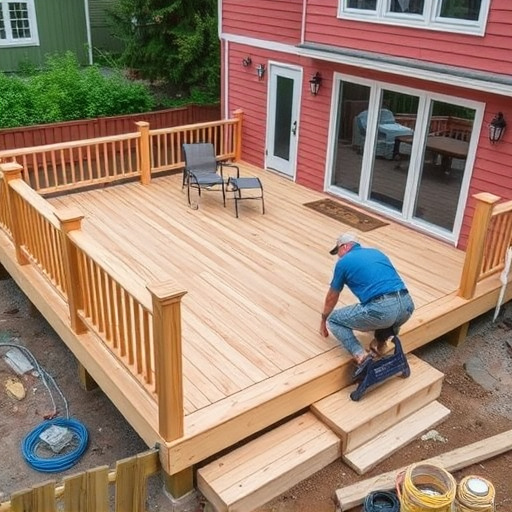
When designing or enhancing your patio deck, choose privacy screen material based on durability, aes…….
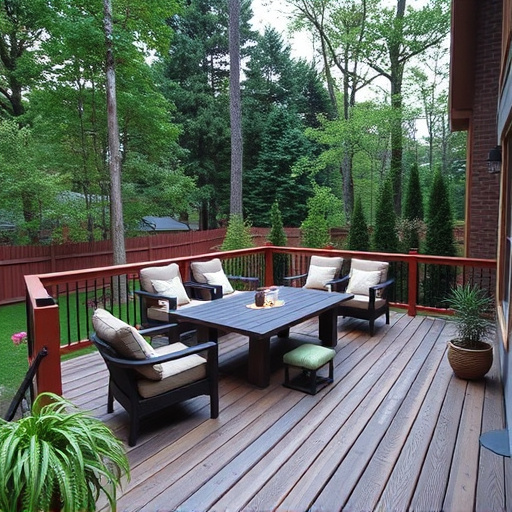
Blending fire pits with kitchens on patio decks creates vibrant entertainment hubs that foster socia…….
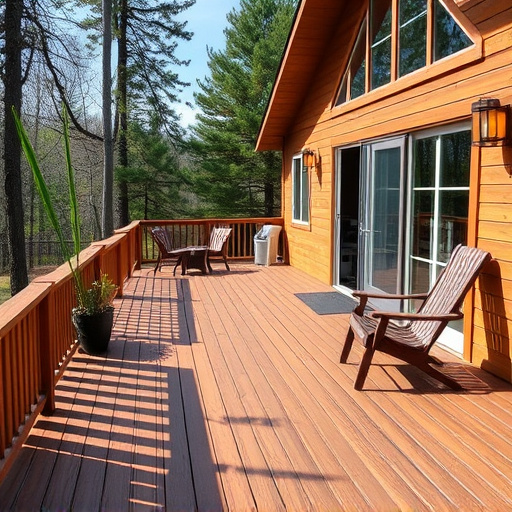
Designing a patio deck involves choosing durable, aesthetically pleasing materials like composite de…….
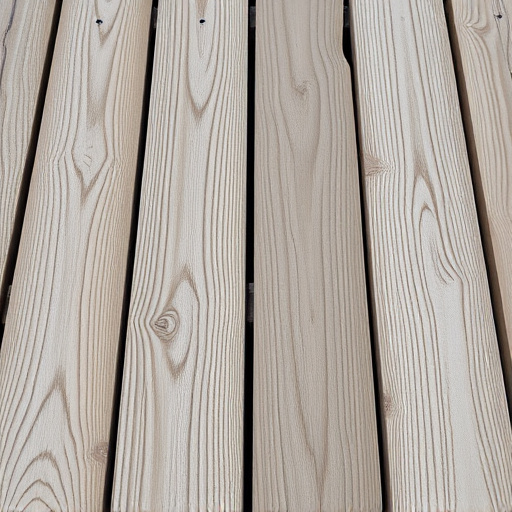
Before designing your patio deck layout, assess space, functional needs, and intended use (entertain…….